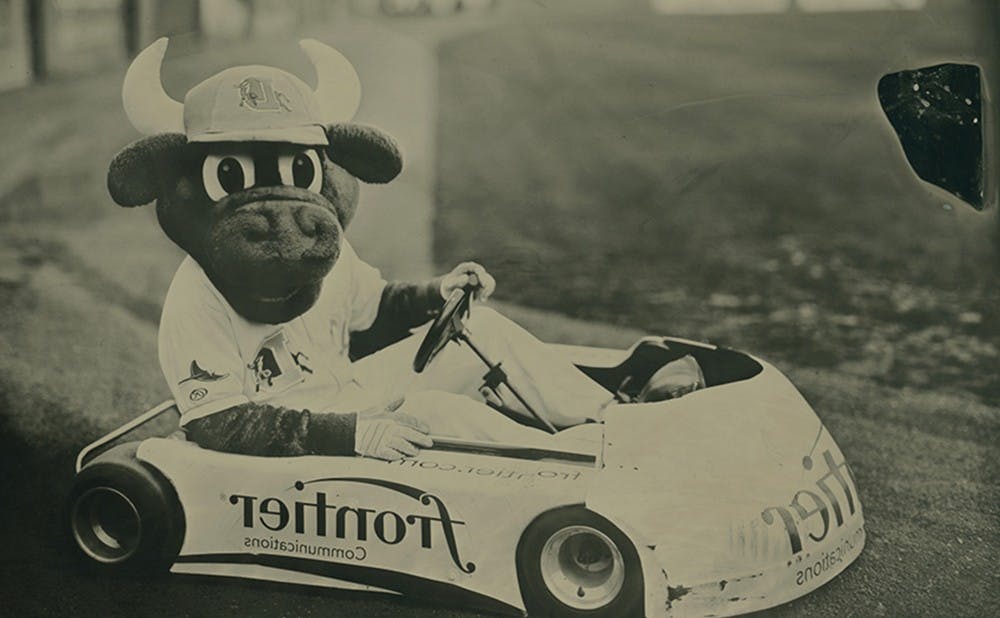“The project originated about three and a half years ago at the end of the Jazz Loft Project because I was ready to document something contemporary, something happening now,” Sam Stephenson, North Carolina native and director of the Jazz Loft Project and Bull City Summer, said. “Durham Bull games are one of the few places you can go where you can see all walks of life from a 50-mile radius in a single structure.”
The Durham Bulls’ 2013 season was chosen in part because it coincided with the 25th anniversary of the release of the film “Bull Durham.” The movie has been a cornerstone of pop culture and features Durham’s own minor league baseball team and the community that surrounds it.
“What I think is really fascinating is that this project is fundamentally about the Durham Bulls, a season of baseball in America, but the photographers and artists involved in this project don’t necessarily have a history with baseball or the team,” Emma Miller (T’12), a contributing organizer and writer for the project, said. “The aim was to break away from traditional sports journalism. Some of our contributors are drawn to the sport, but others are drawn to the aesthetics of the sport or the culture of the stadium at large.”
Despite the Durham Bulls’ longstanding history, the stadium itself is only just creeping up on its 20th year. For many of the artists involved in Bull City Summer, the stadium served as a source of inspiration. Kate Joyce, a Chicago-based photographer who had previously studied at the Duke Center for Documentary Studies, admitted that she went through a lot of trial and error in determining how to document her perspective in the stadium.
“I was drawn to the ritual of practice and relating to that as an artist,” Joyce said. “Both my mother and sister were professional dancers and seeing that influence in the ballplayers’ movement was how I developed my perspective. I didn’t know much about baseball, but as a photographer, I identified with the players. We both put in immense amounts of practice, but our work is largely dependent on luck and timing.”
In addition to the exhibition at NCMA, the photography and writing contributed to Bull City Summer will also be published in a book later this year. While Adam Sobsey is the main writing contributor on the project, the book also includes writing from Howard L. Craft and Frances O’Roark Dowell, as well as from Miller, Stephenson and guest writers.
“There’s something in the exhibition and the book that will strike a chord with anybody, whether you are a sports fan or a fine arts aficionado or someone who identifies with the Durham community,” Miller said. “As other contributors have noted, there is not really any other place in Durham where there is such a diverse range of people that come to one space as a community.”
Though their stadium is relatively new, the team is entrenched in their history. Bull City Summer only follows one season of the Durham Bulls, but the team has existed for over a century; in fact, the team name has shifted from the Durham Tobacconists to the Raleigh-Durham Triangles to the currently recognized Durham Bulls.
The exhibit and book aim to strike a conversation not only between the images and writing, but also between its historical and contemporary identities. Stephenson hopes that it will inspire reflection about the team and its fans’ own relationships to Durham.
“The Durham Bulls connect the past to the present,” said Stephenson. “They have been playing for over 111 years, so the history of Durham is very potent in the team, but they are also very modern, just as Durham is a modern town and the stadium is a modern ballpark. Durham as a community is not burdened by its past, but continues to honor it—the Durham Bulls are an example of that.”
Bull City Summer runs at the North Carolina Museum of Art until August 31. For more information, visit the NCMA website.
Get The Chronicle straight to your inbox
Signup for our weekly newsletter. Cancel at any time.

